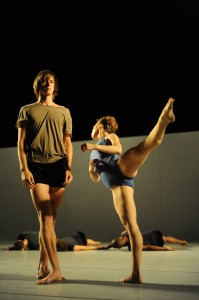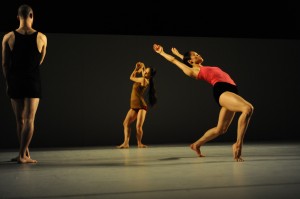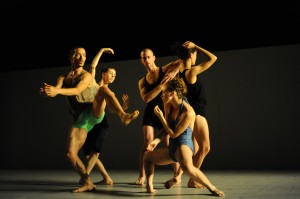Batsheva Dance Company 50th Anniversary Tour
“Sadeh21” U.S. Premiere
Royce Hall, UCLA
Thurs Oct 30, Sat & Sun Nov 1-2
Touring the U.S. for the company’s 50th anniversary year, Batsheva Dance Company performed 3 shows at UCLA last week. The first was an invitation-only event: a rare assemblage of L.A.-area dance artists and associated arts people, all invited to the show gratis by Kristi Edmunds, CAP-UCLA’s bold executive director. Seats were also granted that night to a number of UCLA undergrad classes, who entered in nervous huddles, worrying loudly about the homework assignments springing from the performance. On Saturday and Sunday, Batsheva performed at Royce Hall for the general public.
A single program appeared throughout the weekend: the U.S. premiere of artistic director Ohad Naharin’s “Sadeh21,” a collection of linked movement studies created back in 2010, featuring superior ambient and sonic music from the likes of Auetchre & The Hafler, Brian Eno & Harold Budd and David Darling, among others.
Frankly, at the start of the performance, I was worried, too. The cool press shots of “Sadeh21” — featuring the dancers in abstract duets and small groupings, looking so busily serious and self-directed — harkened to the indiscernible Naharin piece we saw here last summer: “Passo,” created for Natalia Osipova and Ivan Vasiliev on their “Solo for Two” tour. Whatever question or intention fueled that piece never broke through its surface cool to become available that night. A certain part of the problem was simply comparing the distant, difficult vibe of “Passo” to Naharin’s other recent piece on offer out here — the glorious, riveting structure of “MInus 16,” performed so splendidly on Alvin Ailey’s last tour.
At first, it seemed like “Sadeh21” might share “Passo”’s thick, tough membrane. Against a low, opaque wall, one dancer at a time emerged, launching into hiccoughing, idiosyncratic phrases that moved between full-body contemporary technicalia (backbend-layouts and drop-dead leg extensions) and contorted adagio poses and misshapen traveling steps. Yet the dancers were each and all so perfectly mesmerizing, so energetically and physically fierce, something — not necessarily ‘meaning,’ but something more akin to a sense of central focus, a heated core — began to build.
The piercing image of a man carrying a woman slung over his shoulder, a complete dead weight heaped onto his frame as he walked downstage, launched the second section. From here on, each ensuing section of “Sadeh21” dug into deeper and more unusual relationship territories. Gender roles were kneaded into a knotty loaf throughout, as when the company women performed a series of beautiful, delicate unison phrases that seemed as if they were rocking just enough to propel one’s imagined penis to move independently. Upstage, meanwhile, the troupe’s men, wearing Ariel Cohen’s voluminous off-the-shoulder A-line dress constructions, spun and leapt faster and faster, until their soaring shapes created a succession of changing patterns and actions, like a horizontal kaleidoscope.
Interplay with the audience — which often figures so richly in Naharin’s work — wasn’t overt here, but seemed to be addressed in the scene of a man gibbering to the audience with great enthusiasm. Standing alone downstage, making direct audience eye contact, he eagerly expressed his incoherent phrases again and again. Is this how Naharin sees so much contemporary dance? An intense ‘performance’ is delivered, yet the dancer possesses no precise language to transmit?
One thinks of Yeats:
“Things fall apart; the centre cannot hold;/
…
The best lack all conviction, while the worst/
Are full of passionate intensity.”
By the end of Naharin’s journey in “Sadeh21,” Oharin’s emerging energetic nexus from section one is made manifest in a delicate, moving “centre,” as the dancers join hands in a stepping and expanding circle. The glorious surprise ending takes all these images even further.
Dancers who aim only to ‘perform’ complete, apprehended movement phrases; who have blazing technical control and the will to maintain energetic focus; who are trained by Gaga and yoga and military time and everything else in our omnivorous culture; who are equally matched as solo artists and unison dancers– again and again it seemed in “Sadeh21” that these luminous Batsheva dancers were offering a rare glimpse into the future of honest bodies in abstract dance.


